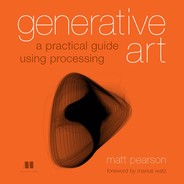Table of Contents
Chapter 1. Generative Art: In Theory and Practice
1.1. Not your father’s art form
1.2. The history of a new idea
Chapter 2. Processing: A Programming Language for Artists
2.2.1. Functions, parameters, and color values
2.3. Structure, logic, and animation
2.5. Saving, publishing, and distributing your work
2.5.3. Using a still as an alt image
Chapter 3. The Wrong Way to Draw a Line
3.1. Randomness and not-so-randomness
3.3.1. Perlin noise in Processing
Chapter 4. The Wrong Way to Draw a Circle
4.1.1. Drawing your first circle
6.2. Object-oriented programming
7.2. Simulation and visualization
8.4. Case study: Sutcliffe Pentagons
..................Content has been hidden....................
You can't read the all page of ebook, please click here login for view all page.
